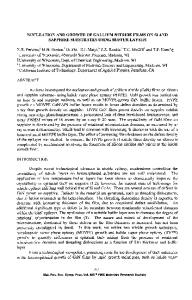Epitaxial Growth of III-Nitride Layers on Aluminum Nitride Substrates
- PDF / 340,055 Bytes
- 6 Pages / 612 x 792 pts (letter) Page_size
- 78 Downloads / 336 Views
Physics, Appl. Physics, & Astronomy Dept., Rensselaer Polytechnic Inst., Troy, NY 12180, [email protected] = Crystal IS, Inc., Latham, NY 12110
Cite this article as: MRS Internet J. Nitride Semicond. Res. 4S1, G3.76 ABSTRACT High quality, epitaxial growth of AlN and AlxGa1-xN by OMVPE has been demonstrated on single-crystal AlN substrates. Here we report characterization of epitaxial layers on an a-face AlN substrate using Rutherford Backscattering/ion channeling, atomic force microscopy (AFM), x-ray rocking curves, and preliminary electrical characterization. Ion channeling along the [10 1 0] axis gives a channeling minimum yield of 1.5% indicating a very high quality epitaxial layer. INTRODUCTION While III-nitride epitaxy offers great potential for optoelectronic, high temperature and high power devices, the common use of sapphire has many disadvantages. The use of single crystal III-nitride substrates should allow improved epitaxial growth, improved thermal and chemical compatibility, as well as improved thermal conductivity. We have succeeded in growing single crystals of AlN exceeding 1 cm in length and 0.5 cm in diameter using the technique of sublimation and recondensation [1]. Substrates of AlN have been cut from these single crystals boules with either the ( 1120) (a-face) or the (0001) (c-face) orientation. Here we report preliminary results from the growth of AlN and AlxGa1-xN layers on the a-face substrates. GROWTH PROCEDURES All growths were carried out in an rf-heated, hot-wall, horizontal reactor [2]. The growth temperature was 1100 °C, while the growth pressure was 100 torr. Trimethylaluminum (TMA), trimethylgallium (TMG) and ammonia (NH3) were used as the source materials, and the carrier gas was hydrogen. An AlN substrate and a c-plane sapphire substrate were placed side by side to compare epitaxial quality and calibrate the growth rate. After a chemical clean and prior to the epitaxial growth, the substrates were thermally treated at 1100 °C under 2 slm of hydrogen flow for 5 min and under a mixed stream of 1slm ammonia and 2 slm hydrogen for 10 min. After this treatment, the flow rates of H2 and NH3 were adjusted to 3 slm and 2 slm respectively, and then TMA (for AlN growth) or a combination of TMA and TMG (for alloy growth) was switched into reactor. In all cases, the flow rate of TMA was 30 sccm. Under these conditions, the AlN growth rate was about 0.5 µm/hour (for the sapphire substrate) as determined by FTIR measurements. Typical growth times were about 1.5 hours. The 50% alloy discussed below was achieved with 3sccm and 30sccm flow rates of TMG and
Downloaded from https://www.cambridge.org/core. IP address: 80.82.77.83, on 28 Apr 2018 at 09:59:21, subject to the Cambridge Core terms of use, available at https://www.cambridge.org/core/terms. https://doi.org/10.1557/S1092578300002817
TMA, respectively. Doping was accomplished by using 11.1 ppm silane in a hydrogen carrier gas. CHARACTERIZATION AND ANALYSIS In Fig. 1, an AFM image of an AlN substrate is shown prior to epitaxial growth. This
Data Loading...








